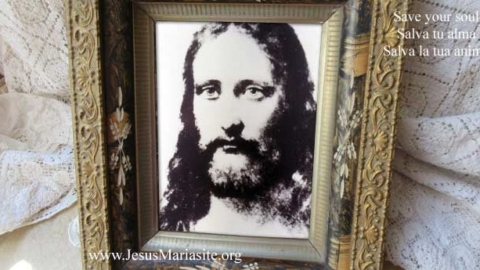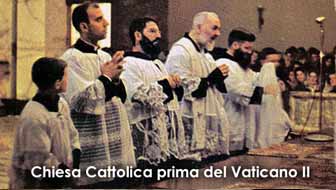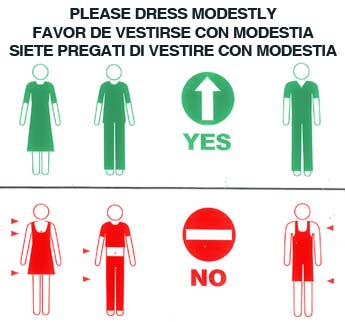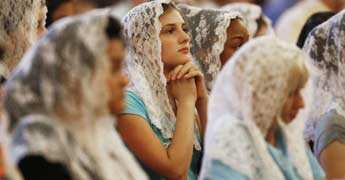St. Rita of Cascia
Saint Rita of Cascia (Born Margherita Lotti 1381 – May 22, 1457) was an Italian Augustinian nun, widow and saint venerated in the Roman Catholic Church. Rita was married at an early age. The marriage lasted for 18 years, during which she is remembered for her Christian values as a model wife and mother who made efforts to convert her husband from his abusive behavior. Upon the murder of her husband by another feuding family, she sought to dissuade her sons from revenge before their calamitous deaths.
She subsequently joined an Augustinian community of religious sisters, where she was known both for practicing mortification of the flesh and for the apparent efficacy of her prayers. St. Rita is venerated due to various miracles attributed to her intercession, and is often portrayed with a bleeding wound on her forehead, which the Roman Catholic Church claims she experienced as a partial stigmata.
The Roman Catholic Church, under the pontificate of Pope Leo XIII officially canonized Rita on May 24, 1900, while her feast day is celebrated every May 22. At her canonization ceremony, she was bestowed the title of Patroness of Impossible Causes while in many pious Catholic countries, Rita came to be known to be as patroness for abused wives and heartbroken women.
Early life
Saint Rita was born as Margherita in 1381 in the city of Roccaporena (near Spoleto, Umbria, Italy) where various sites connected with her are at present the focus of pilgrimage. At the time of her birth, her parents were known to be noble charitable persons, who gained the epithet Conciliatore di Cristo (English: Peacemakers of Christ). According to pious sources, Rita was originally pursued by a notary named Gubbio but she initially resisted the offer. She was later married at age 12 to a nobleman named Paolo Mancini. Her parents (Antonio Lotti and Amata Ferri) arranged her marriage, a common practice at the time, despite her repeated requests to be allowed to enter a convent of religious sisters. Her husband, Paolo Mancini, was known to be a rich, quick-tempered, immoral man, who had many enemies in the region of Cascia. Rita had her first child at the age of twelve.
Rita endured his insults, physical abuse and infidelities for many years. According to popular tales, through humility, kindness and patience, Rita was able to convert her husband into a better person, more specifically renouncing a family feud known at the time as La Vendetta. Rita eventually bore two sons, Giangiacomo (Giovanni) Antonio and Paulo Maria, and brought them up in the Christian faith which Rita closely followed. As time went by and the family feud between the Chiqui and Mancini families became more intense, Paolo Mancini became congenial, but his allies betrayed him and he was violently stabbed to death by Guido Chiqui, a member of the feuding family.
Paolo Mancini’s brother, Bernardo, was said to have been responsible for continuing the blood family feud in hopes of convincing Rita’s sons to seek revenge. Rita gave a public pardon at Paolo’s funeral to her husbands’ murderers. As her sons advanced in years (one now 16), their characters began to change as Bernardo became their tutor. Later on, Bernardo convinced Rita’s sons to leave their manor and live at the Mancini villa and ancestral home. Rita’s sons wished to revenge their father’s murder. Rita, fearing that her sons would lose their souls, tried to persuade them from retaliating, but to no avail. Accordingly, she petitioned God to take her sons rather than submit them to possible mortal sin and murder. Her sons died of dysentery a year later, which pious Catholic beliefs claim was God’s act to take them by natural death rather than risk them committing a mortal sin punishable by Hell.
After the deaths of her husband and sons, Rita desired to enter the monastery of Saint Mary Magdalene in Cascia but was turned away. Although the convent acknowledged Rita’s good character and piety, the nuns were afraid of being associated with her due to the scandal of her husband’s violent death. However, she persisted in her cause and was given a condition before the convent could accept her: the difficult task of reconciling her family with her husband’s murderers, a public act that ideally nullified the conflict. She was able to resolve the conflicts between the families and, at the age of 36, was allowed to enter the monastery. Popular religious tales recall that the bubonic plague which ravaged Italy at the time, infected Bernardo Mancini, causing him to relinquish his desire to feud any longer with the Chiqui family.
She implored her three patron saints (John the Baptist, Augustine of Hippo, and Nicholas of Tolentino) to assist her, and she set about the task of establishing peace between the hostile parties of Cascia with such success that her entry into the monastery was assured. Pious Catholic legends later recount that she was transported into the monastery of Saint Magdalene via levitation at night into the garden courtyard by these three saints. She remained at the monastery, living by the Augustinian Rule, until her death on May 22, 1457.
Veneration
The “Acta” or life story of Saint Rita was compiled by the Augustinian priest, Father Jacob Carelicci. Rita was beatified under the Pontificate of Pope Urban VIII in 1626. The pope’s own private personal secretary, Cardinal Fausto Poli, had been born some 15 kilometers (9 miles) from her birthplace and much of the impetus behind her cult is due to his enthusiasm. She was canonized on May 24, 1900 under the pontificate of Pope Leo XIII and her feast day was instituted on May 22.
She has acquired the reputation, together with St. Jude, as a saint of impossible cases. Many people visit her tomb each year. French painter Yves Klein had been dedicated to her as an infant. In 1961, he created a Shrine of St. Rita, which is placed in Cascia Convent.
Her body, which has remained incorrupt over the centuries, is venerated today in the shrine at Cascia, which bears her name.
The forehead wound
One day when she was about 60 years of age, she was meditating before an image of Christ crucified, as she was accustomed to do. Suddenly a small wound appeared on her forehead, as though a thorn from the crown that encircled Christ’s head had loosened itself and penetrated her own flesh. For the next 15 years she bore this external sign of stigmatization and union with the Lord.
Roses
A story is told that near the end of her life, Rita was bedridden at the convent. A cousin visited her and asked her if she desired anything from her old home. Rita responded by asking for a rose from the garden. It was January and her cousin did not expect to find anything due to the weather. However, when her relative went to the house, a single blooming rose was found in the garden and her cousin brought the rose and fig back to Rita at the convent. St. Rita is often depicted holding roses or with roses nearby. On her feast day, churches and shrines of St. Rita provide roses to the congregation that are blessed by the priest during Mass. (Source:Wikipedia)
The Bees
In the parish church of Laarne, near Ghent, Belgium, there is a statue of St. Rita in which several bees are featured. This depiction originates from the story of her baptism as an infant. On the day after her baptism, her family noticed a swarm of white bees flying around her as she slept in her crib. However, the bees peacefully entered and exited her mouth without causing her any harm or injury. Instead of being alarmed for her safety, her family was mystified by this sight. According to Butler, this was taken to indicate that the career of the child was to be marked by industry, virtue and devotion.
In your afflictions and sorrow ask St Rita of Cascia to help you
Prayer to St. Rita
O Holy Patroness of those in need, St. Rita, whose pleadings before thy Divine Lord are almost irresistible, who for thy lavishness in granting favors hast been called the Advocate of the Hopeless and even of the Impossible; St. Rita, so humble, so pure, so mortified, so patient and of such compassionate love for thy Crucified Jesus that thou couldst obtain from Him whatsoever thou askest, on account of which all confidently have recourse to thee expecting, if not always relief, at least comfort; be propitious to our petition, showing thy power with God on behalf of thy suppliant; be lavish to us, as thou hast been in so many wonderful cases, for the greater glory of God, for the spreading of thine own devotion, and for the consolation of those who trust in thee.
We promise, if our petition is granted, to glorify thee by making know thy favor, to bless and sing thy praises forever. Relying then upon thy merits and power before the Sacred Heart of Jesus, we pray thee grant that [here mention your request].
By the singular merits of thy childhood,
Obtain for us our request.
By thy perfect union with the Divine Will,
Obtain for us our request.
By thy heroic sufferings during thy married life,
Etc. {repeat Obtain for us our request after each line]
By the consolation thou didst experience at the conversion of thy husband,
By the sacrifice of thy children rather than see them grievously offend God,
By the miraculous entrance into the convent,
By thy severe penances and thrice daily bloody scourgings,
By the suffering caused by the wound thou didst receive from the thorn of thy Crucified Savior,
By the Divine love which consumed thy heart,
By that remarkable devotion to the Blessed Sacrament,
on which alone thou didst exist for four years,
By the happiness with which thou didst part from thy trials to join thy Divine Spouse,
By the perfect example thou gavest to people of every state of life.
Pray for us, O holy St. Rita, that we may be made worthy of the promises of Christ.
LET US PRAY.
O God, Who in Thine infinite tenderness hast vouchsafed to regard the prayer of Thy servant, Blessed Rita, and dost grant to her supplication that which is impossible to human foresight, skill and efforts, in reward of her compassionate love and firm reliance on Thy promise, have pity on our adversity and succor us in our calamities, that the unbeliever may know Thou art the recompense of the humble, the defense of the helpless, and the strength of those who trust in Thee, through Jesus Christ, Our Lord. Amen.
Novena to St. Rita
O holy protectress of those who art in greatest need, thou who shineth as a star of hope in the midst of darkness, blessed Saint Rita, bright mirror of God’s grace, in patience and fortitude thou art a model of all the states in life. I unite my will with the will of God through the merits of my Savior Jesus Christ, and in particular through his patient wearing of the crown of thorns, which with tender devotion thou didst daily contemplate. Through the merits of the holy Virgin Mary and thine own graces and virtues, I ask thee to obtain my earnest petition, provided it be for the greater glory of God and my own sanctification. Guide and purify my intention, O holy protectress and advocate, so that I may obtain the pardon of all my sins and the grace to persevere daily, as thou didst in walking with courage, generosity, and fidelity down the path of life. [Mention your request.]
Saint Rita, advocate of the impossible, pray for us.
Saint Rita, advocate of the helpless, pray for us.
Recite the Our Father, Hail Mary, and Glory Be three times each.
Movie of Saint Rita of Cascia
Movie: St. Rita of Cascia




















 Pray for the Church, its Hierarchies, the validly ordained and consecrated during this time of confusion and apostasy. Do not fall into the trap of division, even with apparent good reasons. Turn your eyes to the lives of saints, such as St. Martin de Porres, St. Padre Pio of Pietrelcina, the former discriminated against and the latter fought by the same institution. Let their behavior in adversity be an example for you to follow…
Pray for the Church, its Hierarchies, the validly ordained and consecrated during this time of confusion and apostasy. Do not fall into the trap of division, even with apparent good reasons. Turn your eyes to the lives of saints, such as St. Martin de Porres, St. Padre Pio of Pietrelcina, the former discriminated against and the latter fought by the same institution. Let their behavior in adversity be an example for you to follow…

 “The Church is God’s house. It is forbidden for men to enter here with bare arms and wearing shorts. It is forbidden for women to enter wearing trousers, bare headed, with short, low-necked or sleeveless dresses.”
“The Church is God’s house. It is forbidden for men to enter here with bare arms and wearing shorts. It is forbidden for women to enter wearing trousers, bare headed, with short, low-necked or sleeveless dresses.”



 “Parents, correct the ways if your family, have much dialogue with your children, make time to listen to them as many homes are being lost due to lack of love, dialogue, understanding and most specially for not inviting God. Take God back into your homes, pray my Holy Rosary, as the family that prays together stays together.”
“Parents, correct the ways if your family, have much dialogue with your children, make time to listen to them as many homes are being lost due to lack of love, dialogue, understanding and most specially for not inviting God. Take God back into your homes, pray my Holy Rosary, as the family that prays together stays together.” 




 January 31, 2022 "Heavenly Father, today, I surrender to You my heart. Help me to be Your instrument in the world. Cover me with the Precious Blood of Your Divine Son. Guard me against all evil. Protect me from any evil plan Satan may have for me today. Clothe me in Your Divine Will. Amen"
January 31, 2022 "Heavenly Father, today, I surrender to You my heart. Help me to be Your instrument in the world. Cover me with the Precious Blood of Your Divine Son. Guard me against all evil. Protect me from any evil plan Satan may have for me today. Clothe me in Your Divine Will. Amen" "O Hearts of Jesus and Mary; I consecrate myself, I consecrate my family and the whole world, to your Most Beloved Hearts. Listen to the supplication which I making to you and accept our hearts in Yours, to be delivered and protected we, the whole world, from all evil and all sin. May the protection of your Two Hearts be refuge, strength, and protection, in the daily spiritual struggles. That the power of your Two Hearts irradiates the world so that it is protected from evil and sin. We willingly consecrate ourselves and consecrate all mankind to your Hearts; sure and confident, for your Great Mercy, to obtain the victory over the forces of evil in this world, and the eternal Glory in the Kingdom of God. Amen"
"O Hearts of Jesus and Mary; I consecrate myself, I consecrate my family and the whole world, to your Most Beloved Hearts. Listen to the supplication which I making to you and accept our hearts in Yours, to be delivered and protected we, the whole world, from all evil and all sin. May the protection of your Two Hearts be refuge, strength, and protection, in the daily spiritual struggles. That the power of your Two Hearts irradiates the world so that it is protected from evil and sin. We willingly consecrate ourselves and consecrate all mankind to your Hearts; sure and confident, for your Great Mercy, to obtain the victory over the forces of evil in this world, and the eternal Glory in the Kingdom of God. Amen" "O Virgin of Carmel, may the power of your Holy Scapular take away from me the enemy of my soul; bless me, Mother of Carmel, and deliver me from all evil and danger in this world. I ask you O Mother, that in the hour of my death, your Holy Scapular frees me from the fury of the devil and in the eternity, of the eternal fire. Amen"
"O Virgin of Carmel, may the power of your Holy Scapular take away from me the enemy of my soul; bless me, Mother of Carmel, and deliver me from all evil and danger in this world. I ask you O Mother, that in the hour of my death, your Holy Scapular frees me from the fury of the devil and in the eternity, of the eternal fire. Amen" 
 "Oh Jesus of Divine Mercy, hear my pleadings to you, for I am here to do your Will"
"Oh Jesus of Divine Mercy, hear my pleadings to you, for I am here to do your Will" "O glorious St. Joseph! by your profound humility, by your unalterable meekness, by your invincible patience, by your angelic purity and perfect fidelity that made you a timely imitator of the virtues of Jesus and Mary, I ask you to console me in all my sorrows, to guide me in all my doubts, to defend me in all temptations, to deliver me from all spiritual and material dangers; to extend your arm against all my visible and invisible enemies, breaking and destroying all the snares and barriers that they tend and arm against me. Amen"
"O glorious St. Joseph! by your profound humility, by your unalterable meekness, by your invincible patience, by your angelic purity and perfect fidelity that made you a timely imitator of the virtues of Jesus and Mary, I ask you to console me in all my sorrows, to guide me in all my doubts, to defend me in all temptations, to deliver me from all spiritual and material dangers; to extend your arm against all my visible and invisible enemies, breaking and destroying all the snares and barriers that they tend and arm against me. Amen"  "Oh, blessed Saint Michael, protect us from the attacks and snares of the evil spirits because you know full well that we are poor mortals, fragile and weak, in need of the Mercy of God and of your protection to fulfill the mission that Heaven has commissioned to us. Oh, Saint Michael, may your victorious cry: “who is like God? no one is like God”, suppress and cast into Hell satan and all the evil spirits who prowl about the world seeking the destruction of souls. Amen"
"Oh, blessed Saint Michael, protect us from the attacks and snares of the evil spirits because you know full well that we are poor mortals, fragile and weak, in need of the Mercy of God and of your protection to fulfill the mission that Heaven has commissioned to us. Oh, Saint Michael, may your victorious cry: “who is like God? no one is like God”, suppress and cast into Hell satan and all the evil spirits who prowl about the world seeking the destruction of souls. Amen" Most sweet Jesus, redeemer of the human race, look down upon us, humbly prostrate before your altar. We are yours and yours we wish to be; but to be more surely united with you, behold each one of us freely consecrates himself today to your most sacred heart. Many, indeed, have never known you, many too, despising your precepts, have rejected you. Have mercy on them all, most merciful Jesus, and draw them to your sacred heart. Be you king, O Lord, not only of the faithful who have never forsaken you, but also of the prodigal children who have abandoned you; grant that they may quickly return to their father’s house, lest they die of wretchedness and hunger. Be you king of those who are deceived by erroneous opinions, or whom discord keeps aloof, and call them back to the harbor of truth and unity of faith, so that soon there may be but one flock and one shepherd. Be you king also of all those who sit in the ancient superstition of the Gentiles, and refuse not you to deliver them out of darkness into the light and kingdom of God. Grant, O Lord, to your Church, assurance of freedom and immunity from harm; give peace and order to all nations, and make the earth resound from pole to pole with one cry: Praise to the divine heart that wrought our salvation; to it be glory and honor forever. Amen.
Most sweet Jesus, redeemer of the human race, look down upon us, humbly prostrate before your altar. We are yours and yours we wish to be; but to be more surely united with you, behold each one of us freely consecrates himself today to your most sacred heart. Many, indeed, have never known you, many too, despising your precepts, have rejected you. Have mercy on them all, most merciful Jesus, and draw them to your sacred heart. Be you king, O Lord, not only of the faithful who have never forsaken you, but also of the prodigal children who have abandoned you; grant that they may quickly return to their father’s house, lest they die of wretchedness and hunger. Be you king of those who are deceived by erroneous opinions, or whom discord keeps aloof, and call them back to the harbor of truth and unity of faith, so that soon there may be but one flock and one shepherd. Be you king also of all those who sit in the ancient superstition of the Gentiles, and refuse not you to deliver them out of darkness into the light and kingdom of God. Grant, O Lord, to your Church, assurance of freedom and immunity from harm; give peace and order to all nations, and make the earth resound from pole to pole with one cry: Praise to the divine heart that wrought our salvation; to it be glory and honor forever. Amen.